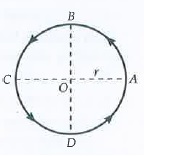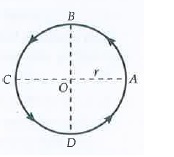In Fig. 3.12 a particle moves along a circular parth of radius r. It starts from point A and moves anticlockwise. Find the distance travelled by the particle as it : moves from A to C

Step by step video & image solution for In Fig. 3.12 a particle moves along a circular parth of radius r. It starts from point A and moves anticlockwise. Find the distance travelled by the particle as it : moves from A to C by Physics experts to help you in doubts & scoring excellent marks in Class 11 exams.
Updated on:21/07/2023Topper's Solved these Questions
Similar Questions
In Fig. 3.12 a particle moves along a circular parth of radius r. It starts from point A and moves anticlockwise. Find the distance travelled by the particle as it : moves from A to B

View SolutionIn Fig. 3.12 a particle moves along a circular parth of radius r. It starts from point A and moves anticlockwise. Find the distance travelled by the particle as it : moves A to D

View Solution
Knowledge Check
A particle moves with constant speed v along a circular path of radius r and completes the circle in time T. The acceleration of the particle is
A2πv/TB2πr/TC2πr2/TD2πv2/TA particle moves along a circular path of radius R. The distance and displacement of a particle after one completer revolution is
A0,2πrB2πr,0C0,πrDπr,0A particle moves along a circular path of radius R. The distance and displacement of a particle after one completer revolution is
A0,2πrB2πr,0C0,πrDπr,0
A particle moves along a circle of radius R. It starts from (A) and moves in antilockwise direction. Calculate the distance travelled by particle (a)one complete revolution. Also calcuate the magnituede of displacement in each case. Fig. 2 (a) .28.
View SolutionA particle is moving along a circular track of radius r. What is the distance traversed by particle in half revolution ? What is its displacement ?
View SolutionDisplacement of a person moving from A to B along a semicircular path of radius R is 100 m. What is the distance travelled by him ?
View SolutionA particle is moving along a circular path of radius of R such that radial acceleration of particle is proportional to t2 then
View SolutionA particle is moving on a circular path of radius R with constant speed v. During motion of the particle form point A to point B

View Solution